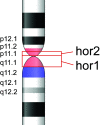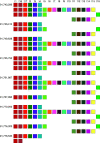Precise identification of cascading alpha satellite higher order repeats in T2T-CHM13 assembly of human chromosome 3
- PMID: 38868967
- PMCID: PMC11157248
- DOI: 10.3325/cmj.2024.65.209
Precise identification of cascading alpha satellite higher order repeats in T2T-CHM13 assembly of human chromosome 3
Abstract
Aim: To precisely identify and analyze alpha-satellite higher-order repeats (HORs) in T2T-CHM13 assembly of human chromosome 3.
Methods: From the recently sequenced complete T2T-CHM13 assembly of human chromosome 3, the precise alpha satellite HOR structure was computed by using the novel high-precision GRM2023 algorithm with global repeat map (GRM) and monomer distance (MD) diagrams.
Results: The major alpha satellite HOR array in chromosome 3 revealed a novel cascading HOR, housing 17mer HOR copies with subfragments of periods 15 and 2. Within each row in the cascading HOR, the monomers were of different types, but different rows within the same cascading 17mer HOR contained more than one monomer of the same type. Each canonical 17mer HOR copy comprised 17 monomers belonging to 16 different monomer types. Another pronounced 10mer HOR array was of the regular Willard's type.
Conclusion: Our findings emphasize the complexity within the chromosome 3 centromere as well as deviations from expected highly regular patterns.
Figures






Similar articles
-
Novel Concept of Alpha Satellite Cascading Higher-Order Repeats (HORs) and Precise Identification of 15mer and 20mer Cascading HORs in Complete T2T-CHM13 Assembly of Human Chromosome 15.Int J Mol Sci. 2024 Apr 16;25(8):4395. doi: 10.3390/ijms25084395. Int J Mol Sci. 2024. PMID: 38673983 Free PMC article.
-
Novel Cascade Alpha Satellite HORs in Orangutan Chromosome 13 Assembly: Discovery of the 59mer HOR-The largest Unit in Primates-And the Missing Triplet 45/27/18 HOR in Human T2T-CHM13v2.0 Assembly.Int J Mol Sci. 2024 Jul 11;25(14):7596. doi: 10.3390/ijms25147596. Int J Mol Sci. 2024. PMID: 39062839 Free PMC article.
-
Global Repeat Map (GRM): Advantageous Method for Discovery of Largest Higher-Order Repeats (HORs) in Neuroblastoma Breakpoint Family (NBPF) Genes, in Hornerin Exon and in Chromosome 21 Centromere.Prog Mol Subcell Biol. 2021;60:203-234. doi: 10.1007/978-3-030-74889-0_8. Prog Mol Subcell Biol. 2021. PMID: 34386877
-
Key-string algorithm--novel approach to computational analysis of repetitive sequences in human centromeric DNA.Croat Med J. 2003 Aug;44(4):386-406. Croat Med J. 2003. PMID: 12950141 Review.
-
Dynamic interplay between human alpha-satellite DNA structure and centromere functions.Semin Cell Dev Biol. 2024 Mar 15;156:130-140. doi: 10.1016/j.semcdb.2023.10.002. Epub 2023 Nov 4. Semin Cell Dev Biol. 2024. PMID: 37926668 Review.
Cited by
-
Efficient genome monomer higher-order structure annotation and identification using the GRMhor algorithm.Bioinform Adv. 2024 Nov 28;4(1):vbae191. doi: 10.1093/bioadv/vbae191. eCollection 2024. Bioinform Adv. 2024. PMID: 39659587 Free PMC article.
References
MeSH terms
Substances
LinkOut - more resources
Full Text Sources

